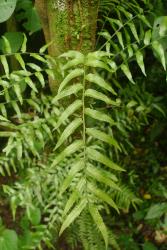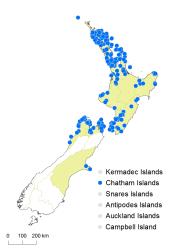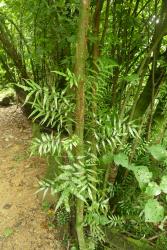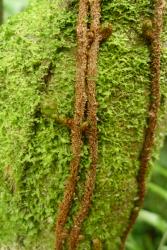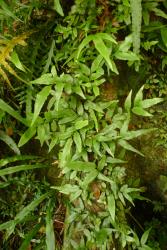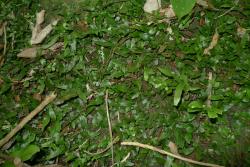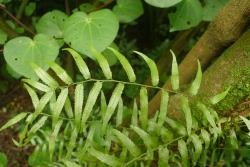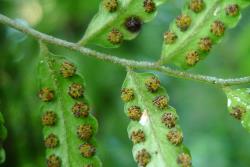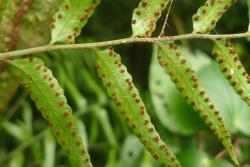- ≡ Polypodium tenellum G.Forst., Fl. Ins. Austr. 81 (1786)
- = Arthropteris filipes T.Moore, Gard. Chron. 23: 388 (1855)
Rhizomes long-creeping, up to 1150 mm long (in herbarium specimens), 1.5–2 mm in diameter, with stipes arising 10–70 mm apart; densely covered in scales. Rhizome scales ovate, peltate, 1.5–5 mm long, 0.5–1.2 mm wide, with blackish centres and pale brown margins. Fronds 85–560 mm long. Stipes 7–80 mm long, yellow-brown, bearing frequent multiseptate hairs up to 0.2 mm long and more scattered golden-brown narrowly ovate scales up to 1.5 mm long. Rachises yellow-brown throughout, not winged or narrowly winged distally, bearing curved hairs up to 0.2 mm long, and scattered scales to 1 mm long. Laminae 1-pinnate, ovate or elliptic or obovate, scarcely tapering at the apices, with a conform terminal pinna, 75–520 mm long, 35–175 mm wide, adaxial surface shiny green, abaxial surface paler green, herbaceous or coriaceous, variably covered in curved hairs along pinna costae and occasionally on abaxial surface of lamina. Primary pinnae in 3–18 pairs below terminal pinna, widely spaced, narrowly ovate or narrowly elliptic, articulated to the rachis; the longest variably positioned from near the apex to the base, 25–100 mm long, 5–15 mm wide, apices acute to acuminate, costae prominent, margins entire (mostly on sterile pinnae) or shallowly lobed, rarely with a few deep lobes proximally, bases often auricled on acroscopic side, short-stalked. Sori round, 1–2 mm diameter, exindusiate; hairs present amongst sporangia.
Mature plants of Arthropteris tenella are recognised by their long-climbing rhizomes, pinnate fronds, narrowly ovate and shallowly lobed pinnae jointed to the rachis, and round exindusiate sori near the lamina margins. Measurements in the description are for fertile fronds only. Juvenile plants are frequently found climbing over rocks and boulders, and bear much smaller sterile fronds with fewer pairs of shorter pinnae; fronds on such plants are occasionally bipinnate. Larger fertile fronds are rarely produced until the rhizome climbs a tree trunk. Plants from the Three Kings Islands have sterile fronds with ovate pinnae up to 63 mm long and 18 mm wide (e.g. AK 353108, which is larger than any seen elsewhere, although the fertile pinnae are within the range for the species).
North Island: Northland, Auckland, Volcanic Plateau, Gisborne, Taranaki, Southern North Island.
South Island: Western Nelson, Sounds-Nelson, Canterbury.
Three Kings Islands, Chatham Islands.
Altitudinal range: 0–400 m.
Arthropteris tenella is found on the Three Kings Islands and is common in coastal and lowland districts from near Kaitāia to Waikato. It occurs around the west coast to Wellington, and around the Bay of Plenty and east coast as far as Hawke’s Bay, but is apparently absent from most of southern Hawke’s Bay and Wairarapa. It is common in lowland districts from Palmerston North to Wellington. It grows from near sea level, reaching 400 m in Waimā Forest, Northland, and on Mt Hobson, Great Barrier Island. In the South Island it occurs around the coast from the Marlborough Sounds to the Porarari River, north Westland, with an outlying population on Banks Peninsula. It ranges from near sea level to 265 m at Dry River, Tākaka. It also reaches the Chatham Islands.
Also Australia (Queensland, New South Wales), Norfolk Island and Lord Howe Island.
Arthropteris tenella often scrambles over rocks, boulders and stumps before climbing a tree trunk and forming fertile fronds. It is most commonly found in coastal and broad-leaved forest, or sometimes in kauri or podocarp forest or under tall kānuka. It frequently grows on limestone but also on greywacke, basalt, lava, scoria and other acidic rock. It favours rocky ground under forest, in stream beds, on river terraces, in gorges and gullies, and on forest margins.
n = c. 42 (Brownlie 1958).
Arthropteris tenella is closely related to A. submarginalis from Queensland (Zhang et al. 2016), differing in its larger frond and exindusiate sori.



